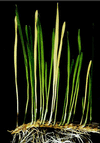Molecular basis for semidominance of missense mutations in the XANTHA-H (42-kDa) subunit of magnesium chelatase
- PMID: 9990095
- PMCID: PMC15580
- DOI: 10.1073/pnas.96.4.1744
Molecular basis for semidominance of missense mutations in the XANTHA-H (42-kDa) subunit of magnesium chelatase
Abstract
During biosynthesis of bacteriochlorophyll or chlorophyll, three protein subunits of 140, 70, and 42 kDa interact to insert Mg2+ into protoporphyrin IX. The semidominant Chlorina-125, -157, and -161 mutants in barley are deficient in this step and accumulate protoporphyrin IX after feeding on 5-aminolevulinate. Chlorina-125, -157, and -161 are allelic to the recessive xantha-h mutants and contain G559A, G806A, and C271T mutations, respectively. These mutations cause single amino acid substitutions in residues that are conserved in all known primary structures of the 42-kDa subunit. In vitro complementation and reconstitution of Mg-chelatase activity show that the 42-kDa subunits are defective in the semidominant Chlorina mutants. A mutated protein is maintained in the Chlorina plastids, unlike in the xantha-h plastids. Heterozygous Chlorina seedlings have 25-50% of the Mg-chelatase activity of wild-type seedlings. Codominant expression of active and inactive 42-kDa subunits in heterozygous Chlorina seedlings is likely to produce two types of heterodimers between the strongly interacting 42-kDa and 70-kDa subunits. Reduced Mg-chelatase activity is explained by the capacity of heterodimers consisting of mutated 42-kDa and wild-type 70-kDa protein to bind to the 140-kDa subunit. The 42-kDa subunit is similar to chaperones that refold denatured polypeptides with respect to its ATP-to-ADP exchange activity and its ability to generate ATPase activity with the 70-kDa subunit. We hypothesize that the association of the 42-kDa subunit with the 70-kDa subunit allows them to form a specific complex with the 140-kDa subunit and that this complex inserts Mg2+ into protoporphyrin IX.
Figures



References
-
- Willows R D, Gibson L C D, Kannangara C G, Hunter C N, von Wettstein D. Eur J Biochem. 1996;235:438–443. - PubMed
-
- Jensen P E, Gibson L C D, Henningsen K W, Hunter C N. J Biol Chem. 1996;271:16662–16667. - PubMed
-
- Jensen P E, Willows R D, Petersen B L, Vothknecht U C, Stumann B M, Kannangara C G, Henningsen K W, von Wettstein D, Henningsen K W. Mol Gen Genet. 1996;250:383–394. - PubMed
-
- Kannangara C G, Vothknecht U C, Hansson M, von Wettstein D. Mol Gen Genet. 1997;254:85–92. - PubMed
Publication types
MeSH terms
Substances
Associated data
- Actions
LinkOut - more resources
Full Text Sources
Other Literature Sources

